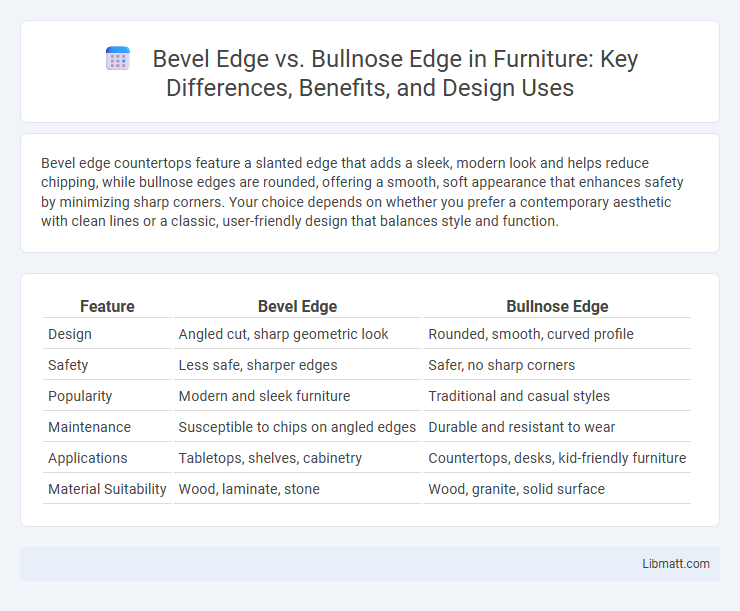Bevel edge countertops feature a slanted edge that adds a sleek, modern look and helps reduce chipping, while bullnose edges are rounded, offering a smooth, soft appearance that enhances safety by minimizing sharp corners. Your choice depends on whether you prefer a contemporary aesthetic with clean lines or a classic, user-friendly design that balances style and function.
Table of Comparison
| Feature | Bevel Edge | Bullnose Edge |
|---|---|---|
| Design | Angled cut, sharp geometric look | Rounded, smooth, curved profile |
| Safety | Less safe, sharper edges | Safer, no sharp corners |
| Popularity | Modern and sleek furniture | Traditional and casual styles |
| Maintenance | Susceptible to chips on angled edges | Durable and resistant to wear |
| Applications | Tabletops, shelves, cabinetry | Countertops, desks, kid-friendly furniture |
| Material Suitability | Wood, laminate, stone | Wood, granite, solid surface |
Introduction to Countertop Edge Profiles
Bevel edge and bullnose edge are popular countertop edge profiles that enhance both aesthetics and functionality in kitchen and bathroom designs. Bevel edges feature a sloped, angled cut that creates a sleek, modern look and helps prevent sharp corners, while bullnose edges are fully rounded for a smooth, soft appearance that maximizes safety, especially in homes with children. Selection between these edges depends on style preference and usage needs, with bevels offering contemporary appeal and bullnose providing classic durability.
What is a Bevel Edge?
A bevel edge features a slanted surface that connects the top of a countertop to its vertical face, typically angled between 15 to 45 degrees, creating a sleek and modern look. This design reduces sharpness while adding subtle dimension and is popular in kitchen and bathroom countertops made from materials like granite, quartz, or marble. You can choose a bevel edge to enhance safety and bring a refined aesthetic to your surfaces without compromising durability.
What is a Bullnose Edge?
A bullnose edge features a rounded, smooth curve that softens the countertop's perimeter, enhancing safety and aesthetics by eliminating sharp corners. Commonly used in kitchens and bathrooms, this edge style prevents chipping and provides a classic, timeless appearance. Its full or partial rounded profile contrasts with the straight, angled cut of a bevel edge, offering a more gentle, approachable design.
Visual Aesthetics: Bevel vs Bullnose
Bevel edge countertops create a sleek, angled finish that adds a modern and geometric appeal to kitchen or bathroom surfaces, emphasizing clean lines and sharp transitions. Bullnose edges offer a smooth, rounded profile that softens countertop corners, enhancing warmth and safety with a classic, timeless look. The choice between bevel and bullnose edges influences the overall visual style, with bevel edges delivering contemporary elegance and bullnose edges promoting a cozy, traditional ambiance.
Durability and Maintenance Comparison
Bevel edges, featuring a slanted angle, offer increased durability by reducing chipping risk on countertop surfaces compared to bullnose edges, which have a rounded profile more susceptible to wear and damage over time. Maintenance for bevel edges is typically easier due to their sharper lines allowing straightforward cleaning, while bullnose edges require more frequent upkeep to prevent grime buildup in the curves. Both edge types benefit from regular sealing on materials like granite or quartz to enhance longevity and maintain appearance.
Safety Considerations: Bevel vs Bullnose
Bevel edges feature angled cuts that reduce sharpness but may still cause minor injuries upon impact, making them moderately safe for environments with children. Bullnose edges have fully rounded contours, minimizing the risk of cuts and bruises, thereby offering superior safety, especially in high-traffic areas. Choosing between bevel and bullnose edges depends on balancing design aesthetics with the level of safety needed in specific settings such as homes or schools.
Cost Differences: Bevel Edge vs Bullnose Edge
Bevel edges typically cost less than bullnose edges due to simpler cutting techniques and less material removal, making them a budget-friendly option for countertop finishing. Bullnose edges involve more labor-intensive shaping and polishing to achieve the rounded profile, resulting in higher fabrication costs. The choice between bevel and bullnose edges directly impacts the overall project budget depending on the level of craftsmanship and finishing requirements.
Best Applications for Each Edge Type
Bevel edges are best suited for modern kitchen countertops, providing a sleek, angled look that enhances contemporary design and reduces sharp corners for safety. Bullnose edges are ideal for bathroom vanities and high-traffic surfaces, offering a smooth, rounded contour that prevents chipping and provides a softer, more traditional aesthetic. Each edge type complements different environments by balancing functionality and style tailored to specific usage demands.
Design and Customization Options
Bevel edge countertops offer a sleek, angular design with a subtle slope that enhances modern and minimalist aesthetics, allowing customization in the angle and width of the bevel to create unique visual effects. Bullnose edges feature a fully rounded, smooth contour that provides a classic, soft look ideal for traditional or transitional styles, with variations in the radius size to match different design preferences. Both edge styles can be paired with various materials like granite, quartz, or marble, enabling tailored finishes and colors to suit specific kitchen or bathroom designs.
How to Choose Between Bevel and Bullnose Edges
Choosing between bevel and bullnose edges depends on the desired aesthetic and functionality of the surface. Bevel edges create a sharp, angled look that adds visual depth and modern appeal, ideal for contemporary kitchen or bathroom countertops. Bullnose edges offer a smooth, rounded finish that enhances safety and comfort, making them suitable for high-traffic areas or homes with children.
Bevel edge vs bullnose edge Infographic

 libmatt.com
libmatt.com